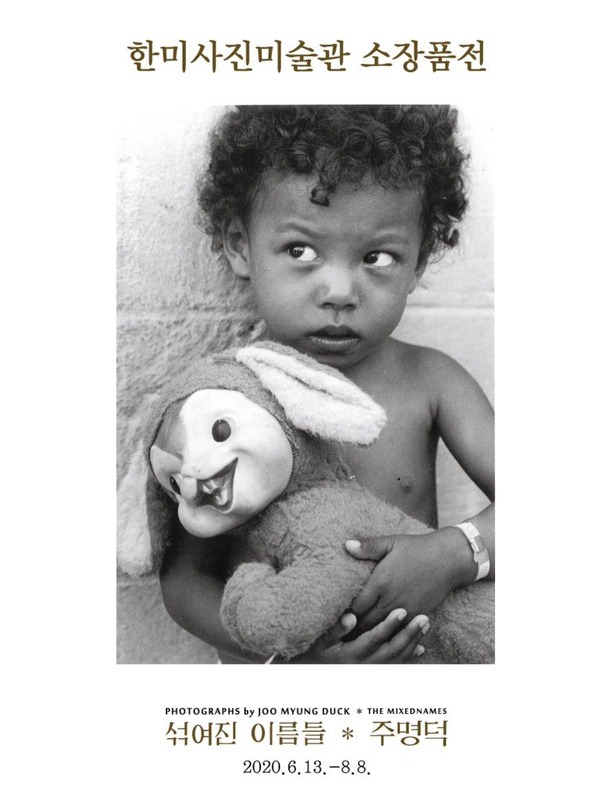
| Period| | 2020.06.13 - 2020.08.08 |
|---|---|
| Operating hours| | 10:00 - 19:00 |
| Space| | MUSEUM HANMI BANGI/Seoul |
| Address| | 14, Wiryeseong-daero, Songpa-gu, Seoul, Republic of Korea |
| Closed| | Sun. |
| Price| | Adult : 6,000 KRW Student, Songpa-gu resident, photography student : 5,000 KRW Group (adult) More than 10 people :5,000 KRW Group (student) : 4,000 KRW |
| Phone| | 02-418-1315 |
| Web site| | 홈페이지 바로가기 |
| Artist| |
|
정보수정요청



|
|
Exhibition Information
Museum of Photography of Korea and U.S will begin its first exhibition in 2020 with the collection exhibition <The Mixednames>. This year marks the 75th anniversary of the outbreak of the Korean War and the 55th anniversary of the opening of the <PHOTO ESSAY Harry Holt Memorial Orphanage> by Joo Myung-duck, an important exhibition of the Korean photography community. The exhibition, which was held in 1966, left a strong message that "the war is not over yet" through the work of recording biracial orphans left in Korean society after the Korean War, and was later published in 1969 as a photo book titled <The Mixednames>. In this exhibition, we will introduce a series of 50 works of <The Mixednames> and <Yongjugol>, and <Uncheon>, which were owned by the Museum of Photography of Korea and U.S, and exhibit works depicting Seoul in the early 1960s to reflect on the meaning of photography as a modern documentary. On April 24, 1966, at the entrance of the Seoul Central Public Information Gallery, a hand-made poster of Joo Myung-duck's <Photo Essay Holt's orphanage> was hung. On the wall of the exhibition hall, 95 small-sized works were hung. The scars of the war, deeply engraved on one side of the hearts of those who turn around after seeing pictures of children born and left behind between foreign soldiers and Korean women who participated in the tragedy of fratricidal war, have been revived. After the war, the Korean photography community focused on factual records. The main idea was that photographs should actively reflect the times, and most of them were pictures with a formative composition. Therefore, all the photographs that record the daily lives of Korean society were masterpieces, but they were not active in dealing with contemporary issues in depth or projecting the author's personal perspective. However, Joo Myung-duck's <Photo Essay Holt's orphanage> was a work that showed the tradition of realism pursued by previous generations of photographers and had a solid narrative structure woven into a theme. The series, which contains a clear sense of subject matter and times as facts and records, showed the potential of Korean photography as a modern documentary photograph that went beyond the limits of realism at the time, with the writer's eyes and emotions on social problems facing or facing the society in the future composed of refined editing. The economic development of the 1960s seemed to overcome the misery of war, but the life of a mixed-race orphan, witnessed by a young photographer in his 20s, was an irresistible truth, an irresistible fact, and a matter of the times that should be shared and held responsible. Photographers did not use their pain for photography. For the pessimistic, it would be dismissed as a tragedy created by the times, but the author saw the hope manifested in their innocence. The series of critical-looking documentaries captured by the author's intuition resonated greatly in Korean society with strong traditional ethnic concepts. <Yongjugol>(1968) and <Uncheon>(1971), which are composed of a series of <The Mixednames> in the collection of the Museum of Photography of Korea and U.S, are a series of works that captures the problem of mixed-race orphans still remaining in the U.S. military presence with a more mature perspective. This work was published in a series in the 1960s through <Monthly JoongAng>, a major monthly magazine on current affairs. In addition, interesting archives of the time will be displayed, including a handwritten letter from a biracial orphan, a 1966 exhibition guest book, and an edited photo book of the artist's own <The Mixednames>. In addition, Joo Myung-duck's Seoul work, which shows urban sensibility based on refined and sensuous framing of the 1960s era, will also be displayed. Joo Myung-duck is a Korean photographer based on his deep affection for the land he live in and his trust in humans. Focusing on the recordability and realism of the photographs, <The Mixednames> deals with traces of war based on a cool-headed historical consciousness, while the Seoul works captured from 1962 to 1965 are a snapshot of the artist's sensibility. It is a habit of a young photographer in his 20s who has not fully studied photography, and the author is humble, but it is an important early work that marks the beginning of his urban series of familiar daily life that continues to this day. A young photographer in his 20s who enjoyed romance as a photographer while traveling through Seoul, which turned into a big city after the war, has already reached his 80s. The walkway of Deoksugung Palace where he was walking turned into a dense stone wall, and the tram running in Seoul disappeared into the distant years. [Source] Museum of Photography of Korea and U.S homepage
